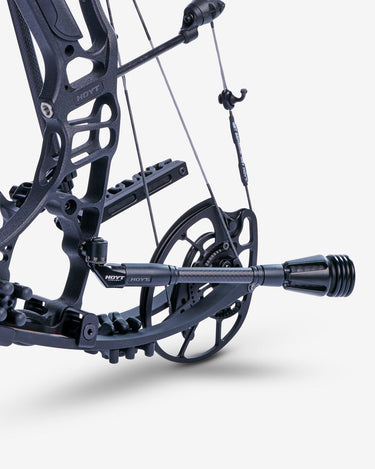Master Your Aim with High-Quality Bow Stabilizers: Store Now!
Master Your Aim with High-Quality Bow Stabilizers: Store Now!
Blog Article
Maximize Your Archery Accuracy With These Bow Stabilizer Methods
One important element that can considerably affect your performance is the proper application of bow stabilizers. Whether you are a skilled archer looking to fine-tune your skills or a newcomer eager to enhance your precision, grasping these bow stabilizer methods could be the trick to hitting your mark with unrivaled uniformity.
Advantages of Making Use Of Bow Stabilizers
Utilizing bow stabilizers can considerably boost an archer's precision and overall efficiency by reducing bow torque and resonance. Bow torque, triggered by the unequal circulation of weight in the bow, can cause disparities in shot positioning. By connecting a bow stabilizer, the weight is rearranged, minimizing the effects of torque and assisting the archer achieve an extra regular shot. Furthermore, bow stabilizers wet vibration, which not just improves the convenience of shooting however also prevents the bow from leaping upon launch, therefore assisting in maintaining correct objective.
Moreover, bow stabilizers can assist in holding the bow constant, particularly during windy problems or when shooting from longer distances. The included weight at the front of the bow provides stability and balance, permitting the archer to focus on aiming without the distraction of bow movement. Generally, the advantages of using bow stabilizers expand past just precision, enhancing the archer's experience and performance in different shooting circumstances.
Choosing the Right Bow Stabilizer
Choosing the proper bow stabilizer is critical for optimizing your archery equipment and improving shooting performance. When selecting a bow stabilizer, there are a number of aspects to think about to guarantee you locate the best fit for your requirements. Think about the weight of the stabilizer. Much heavier stabilizers can help in reducing bow torque and take in more vibration, leading to a steadier aim. Lighter stabilizers provide more maneuverability, which can be beneficial in certain shooting scenarios.

Finally, consider the style of the stabilizer. Some stabilizers feature flexible weights or dampeners that permit you to personalize the balance and feel of your bow. Inevitably, choosing the best bow stabilizer includes locating a balance between weight, material, length, and style to boost your capturing precision and overall performance.
Appropriate Setup Strategies
To make sure optimum Click This Link efficiency and safety in archery, understanding proper installation techniques for your bow stabilizer is vital. The primary step in mounting a bow stabilizer is to determine the right positioning on your bow. The majority of stabilizers are affixed to the front of the riser, listed below the grasp, to aid counterbalance the weight of devices such as quivers and views. Make certain that the stabilizer is not interfering with other elements or impeding your shooting form.
Next, securely attach the stabilizer to the bow making use of the suitable mounting equipment. It is critical to tighten up the stabilizer comfortably to stop any tottering throughout shots. Some stabilizers include adjustable weights that can be included or removed to fine-tune the visit this page balance of your bow. Try out various weight arrangements to discover the optimal equilibrium that fits your shooting design.

Adjusting Stabilizer Weight and Length
After guaranteeing the proper installation of your bow stabilizer, the next action entails adjusting the weight and size to maximize its efficiency in improving archery accuracy. The weight of the stabilizer plays an essential role in minimizing bow activity throughout the shot cycle.
A longer stabilizer can give greater security by enhancing the range in between the bow and the weight at the end of the stabilizer. Conversely, a much shorter stabilizer provides extra ability to move and may be liked by archers who value dexterity and quick activities throughout shooting.
Advanced Stabilizer Tuning Tips
Achieving ideal bow security and accuracy in archery requires a nuanced method to sophisticated stabilizer adjusting. Advanced stabilizer adjusting involves fine-tuning different elements to boost the bow's balance, decrease vibration, and boost total precision.
Another vital facet of innovative stabilizer tuning is optimizing the damping buildings of the stabilizer system. This can be achieved by incorporating extra moistening devices such as rubber dampeners or harmonic stabilizers to additionally lower vibration and noise. Discovering different materials for the stabilizer construction, such as carbon fiber or aluminum, can also influence the bow's performance by modifying its weight circulation and rigidity. By diligently make improvements these innovative stabilizer components, archers can optimize their accuracy and consistency on the range or in competitors.
Final Thought
In verdict, taking full advantage of archery precision can be accomplished via the appropriate option, installation, and change of bow stabilizers. In general, including bow stabilizers into archery method can lead to improved performance and raised accuracy.
Utilizing bow stabilizers can significantly improve an archer's precision and overall performance by decreasing bow torque and resonance. Longer stabilizers supply better stability and balance, specifically for long-distance capturing, while shorter stabilizers use even more versatility and are much easier to steer in limited spaces (bow stabilizer). Carbon fiber stabilizers are sturdy and lightweight, while aluminum stabilizers learn the facts here now are durable and give excellent vibration moistening
A longer stabilizer can supply better stability by increasing the distance between the bow and the weight at the end of the stabilizer.One more critical facet of advanced stabilizer tuning is enhancing the damping residential properties of the stabilizer system.
Report this page